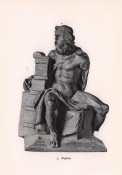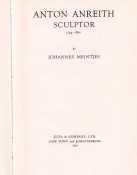Meintjes (Johannes)
ANTON ANREITH sculptor,1754 -1822
Published: Cape Town, 1951
Stock Number: #10204/1
Price: R750
62 pages,8vo (240 x170mm), frontispiece, black and white illustrations, blue cloth, spine faded and frayed at the top and the bottom, corners lightly bumped with marks on the upper cover, a good copy.
Anreith arrived at the Cape of Good Hope as a soldier in the service of the Dutch East-India Company in 1777 on the vessel Woestduijn. Although he was a trained sculptor, he was initially employed as a carpenter. His status changed when, in the 1780s, a wealthy Lutheran named Martin Melck commissioned him to carve a pulpit for the Lutheran Church in Strand Street, Cape Town. In 1786, he was appointed master-sculptor to the Dutch East India Company.In 1789 Thibault and Anreith were joined by Hermann Schutte, an architect and builder from Bremen and the three of them had a profound influence on the development of Cape Town architecture in the late 18th and early 19th centuries. The triumvirate of Thibault, Anreith and Schutte would for many years work from a workshop in the Castle.In addition to his sculpture and plaster-work, Anreith made a living teaching life drawing and geometry. He was also head of the first art school in South Africa which was founded by the Freemasons. He became a Freemason in 1797 as a member of the Lodge de Goede Hoop, for which he designed a number of lime plaster statues, Anton Anreith's later years were marked by poverty, loneliness and a decline in the quality of his work due to frailty.He died in 1822, at his residence at 8 Bloem Street, Cape Town.https://en.wikipedia.org/wiki/Anton_Anreith






